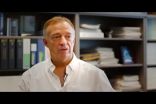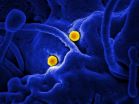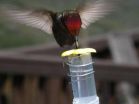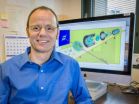(Press-News.org) New evidence suggests that giving the Salk inactivated poliovirus vaccine (IPV) to individuals who had already been given the Sabin live-attenuated oral poliovirus vaccine (OPV) may improve their immunity to the poliovirus. The results, published in the 22 August issue of the journal Science, could help resolve controversy over vaccine choice as researchers work to hasten elimination of final poliovirus reservoirs in places like Syria and Iraq.
"This study revolutionized our understanding of IPV and how to use it in the global eradication effort to ensure children receive the best and quickest protection possible from this disease," said senior author Dr. Bruce Aylward, assistant director-general for Polio, Emergencies and Country Collaboration at the World Health Organization (WHO).
"IPV should be used to accelerate the eradication of the virus in populations that have limited access to vaccination," added Dr. Hamid Jafari, WHO's director for polio operations and research and the lead author of the report. "The study has also provided the evidence for use of IPV among travelers to limit further international spread of the virus."
Since the development of the polio vaccine in the 1950s, efforts to eradicate the poliovirus, which can cause life-long paralysis, relied mainly on OPV—the choice of the Global Polio Eradication Initiative—rather than IPV.
"This is because OPV has a superior ability to induce mucosal immunity, is easy to administer requiring no needles, and is substantially cheaper," said Caroline Ash, a senior editor at Science.
However, in parts of the globe where polio is proving difficult to eradicate, the choice between OPV and IPV continues to be widely debated by scientists. This is because mucosal immunity (the protection offered by the linings that separate the body's sterile interior from the outside world) diminishes rapidly after OPV treatment, meaning several doses of this vaccine are required. And providing multiple doses to eradicate wild poliovirus is challenging in remote areas or conflict zones like Afghanistan, Nigeria and Pakistan.
Furthermore, OPV's use can still lead to polio virus being shed in the stools, which creates risk of viral spreading.
In hopes of one day withdrawing OPV from treatment regimens, Jafari, Aylward and colleagues tested whether use of both vaccines would improve mucosal immunity; although administering IPV after OPV is known to close certain immunity gaps, its effect on intestinal mucosal immunity is less well-characterized.
The international research team conducted a large, community-based, randomized clinical trial in nearly 1,000 infants and children in Uttar Pradesh, a state located in northern India. All subjects were given one vaccine or the other. After four weeks, all subjects, regardless of the initial dose type, got a dose of OPV.
In children who were given IPV, viral shedding was reduced, meaning that these children were much less infectious to others—a key in halting the spread of the virus.
Dr. Jafari and colleagues also found that a single dose of IPV, which is administered by injection, induced intestinal mucosal immunity more effectively in children than an additional OPV dose.
The results of this study could help resolve the 50-year-old controversy, dating back to the time of Jonas Salk and Albert Sabin, over vaccine choice. "The answer is now very clear," explained Dr. Roland Sutter, WHO's coordinator for research and product development, polio operations and research. "Both vaccines complement one another and should be used to interrupt the final chains of transmission to attain a polio-free world in the most rapid and effective way possible."
"The global eradication effort is at a critical crossroad," continued Dr. Jafari. "Endemic polio is increasingly geographically restricted to populations in insecure and inaccessible areas. Yet the virus in these areas persists with incredible tenacity and threatens the increasingly vulnerable populations in polio-free countries with weak or conflict-affected health systems."
INFORMATION:
This study was funded by the Rotary International Polio Plus Program through a grant approved by the Polio Research Committee of the World Health Organization.
Note: This research will be available for free with registration at sciencemag.org when the embargo lifts.
Find the journal Science online:
Website: http://www.scienceonline.org
Facebook: http://www.facebook.com/AAAS.Science
Twitter: @sciencemagazine
YouTube: wwwAAASorg
Share on Twitter: .@sciencemagazine study provides new strategy to eradicate #polio globally #AAAS
The American Association for the Advancement of Science (AAAS) is the world's largest general scientific society, and publisher of the journal Science as well as Science Translational Medicine and Science Signaling. AAAS was founded in 1848, and includes some 261 affiliated societies and academies of science, serving 10 million individuals. Science has the largest paid circulation of any peer-reviewed general science journal in the world, with an estimated total readership of 1 million. The non-profit AAAS is open to all and fulfills its mission to "advance science and serve society" through initiatives in science policy; international programs; science education; and more. For the latest research news, log onto EurekAlert!, http://www.eurekalert.org, the premier science-news Web site, a service of AAAS.
Combined use of polio vaccines effective in boosting immunity
New strategy to eradicate polio globally
2014-08-21
ELSE PRESS RELEASES FROM THIS DATE:
Marine protected areas might not be enough to help overfished reefs recover
2014-08-21
VIDEO:
In this video, Professors Hay and Dixson talk about their research in Fiji and why marine protected areas might not be enough to help overfished areas recover.
Click here for more information.
Pacific corals and fish can both smell a bad neighborhood, and use that ability to avoid settling in damaged reefs.
Damaged coral reefs emit chemical cues that repulse young coral and fish, discouraging them from settling in the degraded habitat, according to new research. The ...
Cause of global warming hiatus found deep in the Atlantic Ocean
2014-08-21
Following rapid warming in the late 20th century, this century has so far seen surprisingly little increase in the average temperature at the Earth's surface. At first this was a blip, then a trend, then a puzzle for the climate science community.
More than a dozen theories have now been proposed for the so-called global warming hiatus, ranging from air pollution to volcanoes to sunspots. New research from the University of Washington shows that the heat absent from the surface is plunging deep in the north and south Atlantic Ocean, and is part of a naturally occurring ...
NIH scientists establish new monkey model of severe MERS-CoV disease
2014-08-21
WHAT:
National Institutes of Health (NIH) scientists have found that Middle East respiratory syndrome coronavirus (MERS-CoV) infection in marmosets closely mimics the severe pneumonia experienced by people infected with MERS-CoV, giving scientists the best animal model yet for testing potential treatments. Researchers at NIH's National Institute of Allergy and Infectious Diseases (NIAID) used marmosets after predicting in computer models that the animals could be infected with MERS-CoV based on the binding properties of the virus.
The same NIAID group in December 2012 ...
How hummingbirds evolved to detect sweetness
2014-08-21
Everything about hummingbirds is rapid. An iridescent blur to the human eye, their movements can be captured with clarity only by high-speed video.
Slowed down on replay, their wings thrum like helicopter blades as they hover near food. Their hearts beat 20 times a second and their tongues dart 17 times a second to slurp from a feeding station.
It takes only three licks of their forked, tube-like tongues to reject water when they expect nectar. They pull their beaks back, shake their heads and spit out the tasteless liquid. They also are not fooled by the sugar substitute ...
From dandruff to deep sea vents, an ecologically hyper-diverse fungus
2014-08-21
A ubiquitous skin fungus linked to dandruff, eczema and other itchy, flaky maladies in humans has now been tracked to even further global reaches—including Hawaiian coral reefs and the extreme environments of arctic soils and deep sea vents.
A review in the scientific journal PLOS Pathogens considers the diversity, ecology, and distribution of the fungi of the genus Malassezia in light of new insights gained from screening environmental sequencing datasets from around the world.
University of Hawai'i at Mānoa scientist Anthony Amend discovered that members of this ...
New properties of rotating superfluids discovered in helium nanodroplets
2014-08-21
Liquid helium, when cooled down nearly to absolute zero, exhibits unusual properties that scientists have struggled to understand: it creeps up walls and flows freely through impossibly small channels, completely lacking viscosity. It becomes a new state of matter – a "superfluid."
Now, a large, international team of researchers led by scientists at USC, Stanford and Berkeley has used X-rays from a free-electron laser to peer inside individual droplets of liquid helium, exploring whether this liquid helium retains its superfluid characteristics even at microscopic scales ...
Severe drought is causing the western US to rise
2014-08-21
The severe drought gripping the western United States in recent years is changing the landscape well beyond localized effects of water restrictions and browning lawns. Scientists at Scripps Institution of Oceanography at UC San Diego have now discovered that the growing, broad-scale loss of water is causing the entire western U.S. to rise up like an uncoiled spring.
Investigating ground positioning data from GPS stations throughout the west, Scripps researchers Adrian Borsa, Duncan Agnew, and Dan Cayan found that the water shortage is causing an "uplift" effect up to ...
X-ray laser probes tiny quantum tornadoes in superfluid droplets
2014-08-21
An experiment at the Department of Energy's SLAC National Accelerator Laboratory revealed a well-organized 3-D grid of quantum "tornadoes" inside microscopic droplets of supercooled liquid helium – the first time this formation has been seen at such a tiny scale.
The findings by an international research team provide new insight on the strange nanoscale traits of a so-called "superfluid" state of liquid helium. When chilled to extremes, liquid helium behaves according to the rules of quantum mechanics that apply to matter at the smallest scales and defy the laws of classical ...
Researchers map quantum vortices inside superfluid helium nanodroplets
2014-08-21
Scientists have, for the first time, characterized so-called quantum vortices that swirl within tiny droplets of liquid helium. The research, led by scientists at the U.S. Department of Energy's Lawrence Berkeley National Laboratory (Berkeley Lab), the University of Southern California, and SLAC National Accelerator Laboratory, confirms that helium nanodroplets are in fact the smallest possible superfluidic objects and opens new avenues to study quantum rotation.
"The observation of quantum vortices is one of the most clear and unique demonstrations of the quantum properties ...
Sunlight, not microbes, key to CO2 in Arctic
2014-08-21
CORVALLIS, Ore. – The vast reservoir of carbon stored in Arctic permafrost is gradually being converted to carbon dioxide (CO2) after entering the freshwater system in a process thought to be controlled largely by microbial activity.
However, a new study – funded by the National Science Foundation and published this week in the journal Science – concludes that sunlight and not bacteria is the key to triggering the production of CO2 from material released by Arctic soils.
The finding is particularly important, scientists say, because climate change could affect when ...
LAST 30 PRESS RELEASES:
Structure of dopamine-releasing neurons relates to the type of circuits they form for smell-processing
Reducing social isolation protects the brain in later life
Keeping the heart healthy increases longevity even after cancer
Young adults commonly mix cannabis with nicotine and tobacco
Comprehensive review illuminates tau protein's dual nature in brain health, disease, and emerging psychiatric connections
Book prepares K-12 leaders for the next public health crisis
Storms in the Southern Ocean mitigates global warming
Seals on the move: Research reveals key data for offshore development and international ecology
Sports injuries sustained during your period might be more severe
World's first successful 2 Tbit/s free-space optical communication using small optical terminals mountable on satellites and HAPS
Can intimate relationships affect your heart? New study says ‘yes’
Scalable and healable gradient textiles for multi‑scenario radiative cooling via bicomponent blow spinning
Research shows informed traders never let a good climate crisis go to waste
Intelligent XGBoost framework enhances asphalt pavement skid resistance assessment
Dual-function biomaterials for postoperative osteosarcoma: Tumor suppression and bone regeneration
New framework reveals where transport emissions concentrate in Singapore
NTP-enhanced lattice oxygen activation in Ce-Co catalysts for low-temperature soot combustion
Synergistic interface engineering in Cu-Zn-Ce catalysts for efficient CO2 hydrogenation to methanol
COVID-19 leaves a lasting mark on the human brain
Scientists use ultrasound to soften and treat cancer tumors without damaging healthy tissue
Community swimming program for Black youth boosts skills, sense of belonging, study finds
Specific depressive symptoms in midlife linked to increased dementia risk
An ‘illuminating’ design sheds light on cholesterol
Who is more likely to get long COVID?
Study showcases resilience and rapid growth of “living rocks”
Naval Research Lab diver earns Office of Naval Research 2025 Sailor of the Year
New Mayo-led study establishes practical definition for rapidly progressive dementia
Fossil fuel industry’s “climate false solutions” reinforce its power and aggravate environmental injustice
Researchers reveal bias in a widely used measure of algorithm performance
Alcohol causes cancer. A study from IOCB Prague confirms damage to DNA and shows how cells defend against it
[Press-News.org] Combined use of polio vaccines effective in boosting immunityNew strategy to eradicate polio globally






